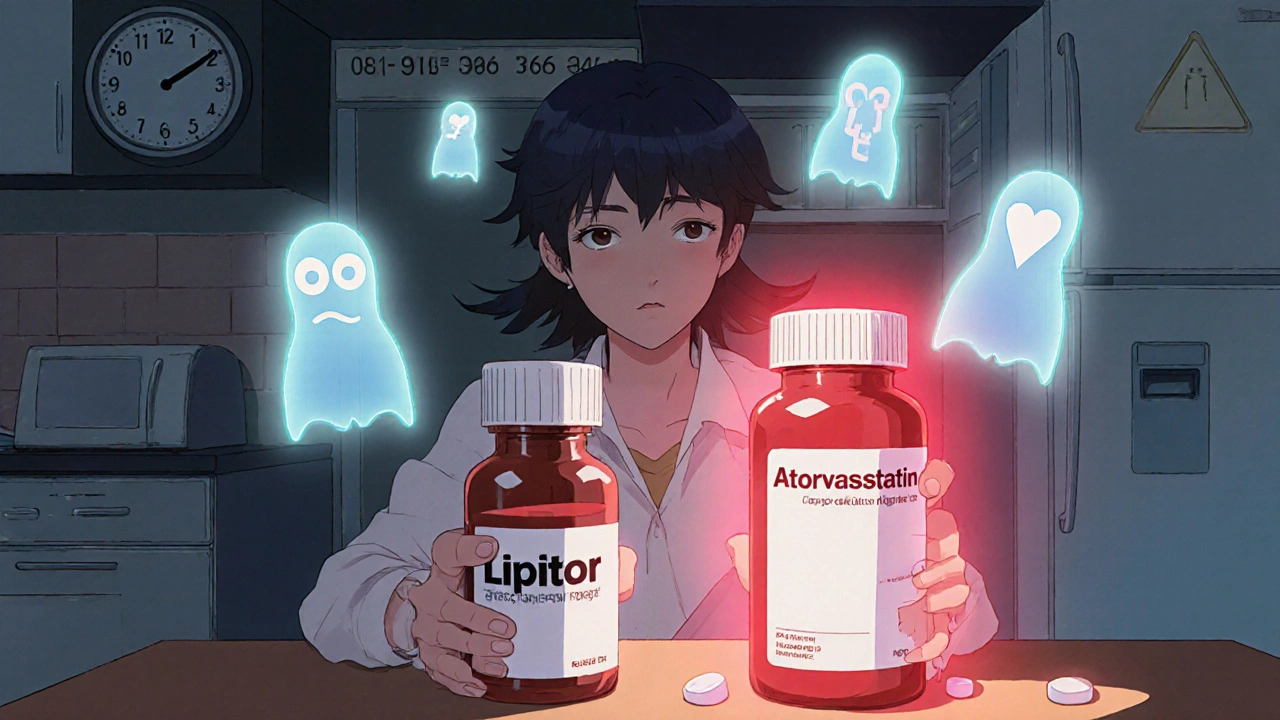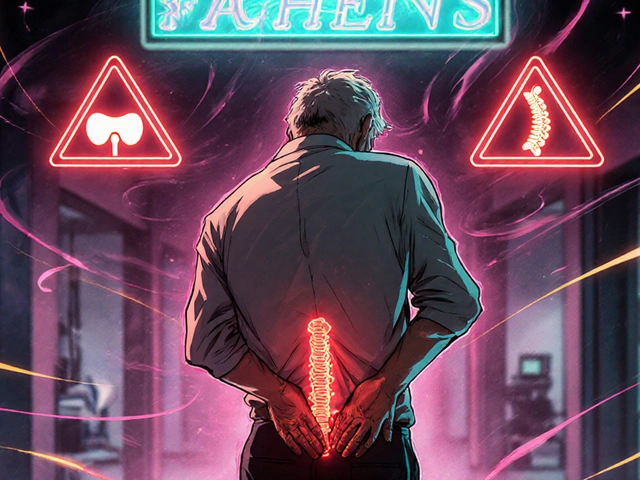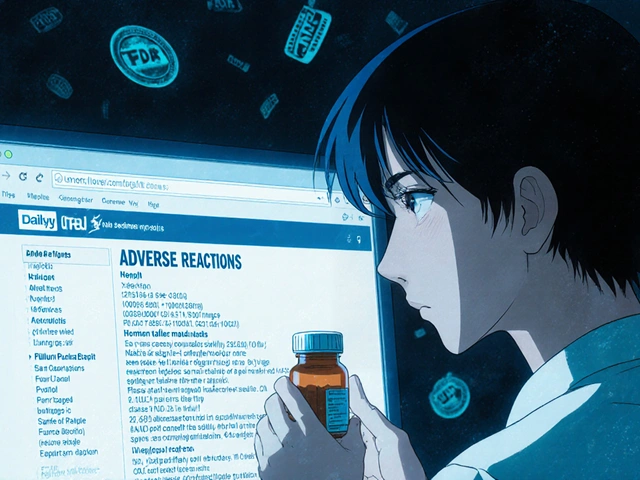Switching from a brand-name drug to a generic version is supposed to be seamless. The FDA says they’re the same-same active ingredient, same dose, same effect. But for some people, things don’t feel right. Maybe you started feeling dizzy after switching to the generic version of your blood pressure pill. Or your headaches got worse after switching from brand-name Topamax to the generic. You’re not imagining it. And you’re not alone.
Here’s the hard truth: side effects after switching to generics are reported more often than you’d think. Not because generics are unsafe, but because small differences in inactive ingredients-like dyes, fillers, or coatings-can trigger reactions in sensitive people. And even if the drug works the same, your brain might blame the generic because you’ve been told generics are "cheaper" or "not as good." That’s perception bias. But whether it’s real or perceived, if something feels off, you need to report it.
Why Reporting Matters
The FDA doesn’t just approve drugs and walk away. They watch what happens after millions of people start taking them. That’s called post-market surveillance. Every year, about 2 million side effect reports flood into the FDA’s Adverse Event Reporting System (FAERS). Most come from drug companies-by law, they have to report anything serious. But about 20% come from patients like you.
Why does your report matter? Because if 10 people report the same strange side effect after switching to the same generic, the FDA might dig deeper. Maybe the manufacturer changed the filler. Maybe a new batch has a contaminant. Maybe the drug isn’t as bioequivalent as claimed. Without your report, that signal gets lost in the noise.
And here’s something most people don’t know: authorized generics-made by the original brand company but sold under a generic label-show fewer side effect reports than regular generics. That’s not because they’re "better." It’s because they use the exact same formula. So if you’re switching and want to minimize risk, ask your pharmacist if an authorized generic is available.
What Counts as a Side Effect Worth Reporting
You don’t need to wait for a hospital visit to report something. The FDA says report anything that’s:
- Unexpected (not listed on the label)
- Severe (like chest pain, trouble breathing, swelling, fainting)
- Long-lasting (keeps going after a few days)
- New (you didn’t feel this way on the brand version)
Even if it’s "just" nausea or insomnia-if it’s new, worse, or doesn’t go away-it’s worth reporting. Especially if you’re on a drug with a narrow therapeutic index. That’s a fancy way of saying: small changes in how your body absorbs it can cause big problems. Think warfarin, levothyroxine, seizure meds like phenytoin, or lithium. If you’re on one of these, pay extra attention after a switch.
How to Report: Step-by-Step
Reporting isn’t hard. But you need the right info. Here’s how to do it right.
- Write down what happened. When did the side effect start? Was it right after you switched? Did it get worse over time? What were you doing when it happened? Be specific. "I felt dizzy every morning after taking the pill" is better than "I felt weird."
- Gather your medication details. Grab the prescription bottle for both the brand and generic versions. You need:
- Brand name (e.g., Lipitor)
- Generic name (e.g., atorvastatin)
- Generic manufacturer (e.g., Teva, Mylan, Sandoz)
- NDC number (10-digit code on the bottle)
- Strength and form (e.g., 20 mg tablet)
- Date you switched
- Call your doctor. Don’t skip this. Your doctor can confirm if your symptoms are likely drug-related. They can also help you fill out the report with your medical history. Many people assume they have to report alone-but doctors can submit reports on your behalf, and they often know exactly what info the FDA needs.
- Choose your reporting method. You have three options:
- Online: Go to www.accessdata.fda.gov/scripts/medwatch and fill out the MedWatch form. It’s free, fast, and takes 15-30 minutes.
- Phone: Call 1-800-FDA-1088. A representative will ask you questions and file the report for you. This is best if you’re feeling unwell or don’t want to type.
- Mail: Request Form FDA 3500B by calling the same number. Fill it out and mail it back. This is slower, but works if you don’t have internet.
- Be clear about the switch. On the form, under "Drug Information," list both the brand and generic names. Write: "Switched from [Brand Name] to [Generic Name] on [Date]. Side effects began after switch."
- Submit it. Don’t wait. The sooner you report, the sooner the FDA can spot a pattern.

What Happens After You Report
You won’t get a thank-you note. But your report goes into a massive database that analysts use to spot trends. If 50 people report the same issue with a specific generic manufacturer’s version of metoprolol, the FDA might ask that company to investigate. Maybe they changed their supplier. Maybe the tablet dissolves differently. They might even issue a warning or recall the batch.
Manufacturers are legally required to respond to serious reports within 15 days. The FDA doesn’t always act on every report-but if enough people report the same thing, action follows.
And here’s something surprising: a 2023 Government Accountability Office report found the FDA doesn’t have a system to automatically flag reports tied to generic switches. That means your clear note about the switch might be the only thing that helps them connect the dots.
Why So Few People Report
Only 12% of patients who experience side effects after switching to generics report them. Why? Three reasons:
- They don’t know how. Most people think reporting is for doctors only.
- They think it won’t matter. "Who cares if I report one case?" But one case is how patterns start.
- They blame themselves. "Maybe I’m just sensitive." Or "It’s probably stress." But if it started the day you switched pills, that’s not stress.
Don’t fall for that. Your experience matters. Even if you’re the first person to report this, you’re helping everyone who comes after you.

What to Do If You’re Still Worried
If you’re scared to switch, talk to your doctor or pharmacist. Ask:
- Is there an authorized generic available?
- Can I try the brand again if the generic causes problems?
- Can I get the same generic manufacturer as before?
Some pharmacies let you request a specific generic brand. If you did fine on Teva’s generic last time, ask for Teva again. Don’t just accept whatever’s cheapest.
And if you’ve had a bad reaction before, keep a note in your phone or wallet: "Switched to generic [drug] on [date] → [side effect]. Do not switch again without consulting doctor."
What’s Changing
The FDA is getting better at this. In 2022, they made the online reporting form 35% faster. They’re also using AI to scan reports for hidden patterns-something that used to take months now takes weeks. And by 2025, they plan to add a checkbox to the reporting form: "Did you recently switch from a brand-name drug?" That small change could make a huge difference.
For now, you’re the eyes on the ground. If you feel something’s wrong after a switch, don’t ignore it. Don’t assume it’s "all in your head." Don’t wait for someone else to report it. You’ve got the power to help fix this system.
Can I report side effects if I didn’t take the generic myself?
Yes. If you’re reporting on behalf of a family member, caregiver, or someone who can’t report themselves, you can still submit the report. Just write "Reported by caregiver" in the reporter section and include their name and contact info. The FDA accepts third-party reports as long as you have enough details about the patient and the medication.
Will reporting a side effect get me kicked off my medication?
No. Reporting side effects doesn’t change your prescription. Your doctor decides what’s right for you. The FDA doesn’t contact patients directly about reports. Your report helps them understand safety trends-not to make decisions about your personal treatment.
What if my doctor says it’s not the medication?
That’s okay. You can still report it. Sometimes, doctors miss connections. If you’re certain the side effect started after the switch, your report adds to the evidence. The FDA doesn’t need medical confirmation to accept a report-they just need clear details about what happened and when.
Are generic side effects more common than brand-name ones?
Not necessarily. The FDA requires generics to be bioequivalent, so they should work the same. But studies show people report side effects more often after switching to generics-even when the drug is identical. That’s likely because of perception bias. Still, real differences happen too: inactive ingredients, manufacturing variations, or individual sensitivity can cause reactions. Reporting helps separate real risks from myths.
Can I report side effects from a generic bought online?
Yes, but be careful. If you bought the drug from an online pharmacy not licensed in the U.S., the FDA may not be able to trace it. Still, report it. Include the name on the bottle, the NDC if visible, and where you bought it. Unlicensed online sellers are a major source of counterfeit or unsafe drugs. Your report might help shut them down.
How long does it take for the FDA to respond to a report?
You won’t get a personal reply. The FDA doesn’t respond to individual reports. But your report goes into a public database that researchers, regulators, and drug companies use. If your report helps identify a pattern, the FDA might issue a safety alert, update labeling, or require changes to manufacturing. That process can take weeks to months.
Is it worth reporting a mild side effect?
Yes. Mild side effects like dry mouth, fatigue, or mild nausea might seem unimportant. But if 50 people report the same mild effect after switching to the same generic, that’s a signal. The FDA tracks both serious and unexpected side effects. What seems minor to you could be the first clue to a bigger problem.







Arup Kuri
24 November, 2025 21:36 PMGenerics are just Big Pharma’s way of getting you hooked on cheap poison so they can sell you the brand again when you start hallucinating from the fillers
My cousin took generic metoprolol and started seeing spiders on the walls-no joke
The FDA? They’re paid off by the big drug companies
They don’t care if you die as long as the stock price stays up
Elise Lakey
26 November, 2025 05:35 AMI switched to a generic thyroid med last year and felt like a zombie for two weeks. I didn’t report it because I thought it was just stress-but now I’m glad I read this. I’m going to file a report tomorrow. Thanks for the clear guide.
It’s scary how little we’re told about these switches.
Roscoe Howard
27 November, 2025 14:30 PMIt is imperative to underscore that the United States Food and Drug Administration maintains rigorous bioequivalence standards for all generic pharmaceuticals, as codified under the Hatch-Waxman Act of 1984. Any anecdotal reports of adverse reactions are statistically negligible and likely attributable to psychological conditioning or noncompliance with dosing protocols. The notion that inert ingredients can induce clinically significant physiological deviations is not supported by peer-reviewed pharmacokinetic data. One must exercise intellectual discipline when interpreting subjective symptomatology.
Kimberley Chronicle
29 November, 2025 10:35 AMInteresting that the GAO highlighted the lack of automated flagging for generic switches-this is a classic case of latent signal detection failure in pharmacovigilance systems. The current FAERS architecture is optimized for spontaneous reporting, but lacks cohort-based temporal clustering algorithms to identify post-switch adverse event clusters. We need NLP-driven triage pipelines to parse "switched from X to Y" phrases and auto-tag them. Otherwise, we’re just throwing data into a black hole.
Shirou Spade
30 November, 2025 13:42 PMIt’s funny how we trust a pill more when it costs more. We’ve been trained to equate price with quality-even when science says otherwise. But the body doesn’t care about branding. It only cares about what’s in the tablet. Maybe the real problem isn’t the generic-it’s the myth we built around the brand.
What if the side effects aren’t from the drug… but from the story we tell ourselves about it?
Lisa Odence
1 December, 2025 09:04 AMOMG YES 😭 I switched to generic Lipitor and started getting muscle cramps so bad I couldn’t walk up stairs. My doctor said "it’s probably just aging" 🙄 I reported it and guess what? Two weeks later, my pharmacy switched me back to the brand-no questions asked. The system works if you speak up! 🙌
Also, the NDC number is on the bottle-don’t skip that part. I didn’t know what it was until I googled it. So much info hidden in plain sight 💡
Pallab Dasgupta
2 December, 2025 15:51 PMBro I was skeptical too until I switched to generic Adderall and went from focused to zombie in 3 days
Then I switched back to brand and boom-clarity returned like flipping a switch
Don’t let them tell you it’s all in your head
My body knows the difference and so should you
Report it. Don’t just suffer. They need to hear this. Millions are silent. Be loud.
Ellen Sales
4 December, 2025 01:52 AMI reported my reaction to generic levothyroxine… and nothing happened. No call. No email. No follow-up. I felt like I’d shouted into a void. But then, six months later, my pharmacist told me the manufacturer changed the filler-and they stopped shipping that batch. My report? It was the 17th one they’d gotten that month. So yeah. It mattered. Even if you don’t see it. It mattered.
fiona collins
5 December, 2025 06:28 AMReport it. Even if it’s small.
giselle kate
5 December, 2025 22:01 PMWhy are we letting foreign manufacturers make our life-saving drugs? China and India control 80% of generic production. Their labs don’t follow our standards. They cut corners. They use cheap dyes. They don’t test for heavy metals. And we’re just supposed to swallow it? Literally?
Buy American. Support domestic pharma. Or suffer the consequences.
Emily Craig
7 December, 2025 14:43 PMSo let me get this straight… you’re telling me if I feel weird after switching to a pill that costs 90% less, I’m supposed to blame the fillers… not the fact that the FDA lets a company in Bangladesh make my blood pressure med?
Also, why do we still use dyes that are banned in the EU? 🤔
Also also, why do we even have generics if the brand version is literally the same formula? Just charge people less. No need to repackage it like a scam.
Karen Willie
9 December, 2025 01:22 AMThank you for writing this. I’ve been too afraid to speak up because I thought I was just being dramatic. But if I’m having insomnia and nausea after switching from brand to generic Prozac… and I didn’t have it before… that’s not me. That’s the pill.
You’re right. One report can start a chain reaction. I’m submitting mine tonight.
Shivam Goel
10 December, 2025 08:04 AMLet’s analyze the data: FAERS receives 2M reports annually, 20% from patients. Assuming 12% of patients who experience post-switch side effects report them, and 30% of generics are switched to in the U.S. annually… that means approximately 1.2M switch events occur yearly. If 15% of those trigger adverse events (per JAMA 2021 meta-analysis), that’s 180K potential unreported cases. The signal-to-noise ratio is catastrophic. Without structured tagging for "switched from brand," we’re drowning in noise. This isn’t about perception-it’s about poor data architecture. The FDA needs to implement mandatory switch flags. Not optional. Mandatory. Or stop pretending this system works.